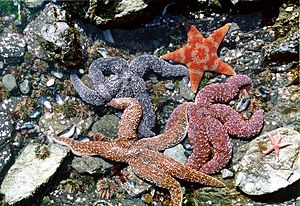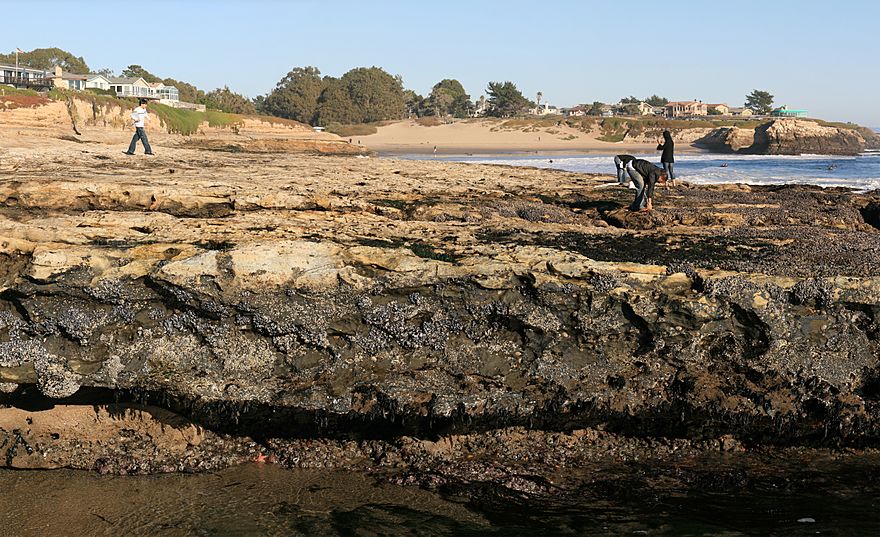Intertidal zone facts for kids
Intertidal zones are special places along the coast. They are the areas between where the water reaches at high tide and where it goes down to at low tide. Imagine a beach that is sometimes covered by the ocean and sometimes dry – that's an intertidal zone!
These zones can be made of rocks, sand, or mud. When the tide is high, they are underwater. When the tide is low, they are exposed to the air. You might find cool rock pools here. These pools are like tiny aquariums left behind by the ocean.
Many different animals and species live in intertidal zones. You can find crabs, shellfish, small fish, and more! Life here is tough because of many things. Waves crash onto the shore, the sunlight can be very strong, and the amount of salt in the water (called salinity) changes a lot. The wind and the changing tides also make it a challenging home.
Scientists have found about 300,000 different species in intertidal zones. These creatures must be super tough! They have to handle strong waves, big changes in temperature, and even drying out when the tide is low.
Contents
Why Living Here is Hard
Life in the intertidal zone is not easy. The animals and plants that live here need special ways to survive.
- Water supply: Ocean creatures need water to live. But in the intertidal zone, the water comes and goes. Animals might be underwater for hours, then completely dry for hours. They need to find ways to stay wet or hold onto water.
- Strong waves: The ocean's waves can be very powerful. They can easily wash away or hurt animals that are not strongly attached. Many creatures here have strong feet or sticky bodies to hold on tight to rocks.
- Temperature changes: When the tide is out, the sun can heat up the rocks and sand a lot. In colder places, it can get very cold. Animals must be able to handle these big temperature swings.
- High salt levels: Sometimes, salt water gets trapped in rock pools. When the sun shines, the water evaporates, but the salt stays behind. This makes the water in these pools much saltier than the ocean. Animals in rock pools need to cope with this extra salt.
Because of these four challenges, the intertidal zone is a very extreme place to live!
High Tide Zone
The high tide zone is the part of the intertidal area that gets covered by water only during high tide. This means it is exposed to the air for most of the day.
Because it's dry for long periods, not many plants can grow here. But some tough ones do! You might find creatures like sea anemones, barnacles, brittle stars, chitons, crabs, green algae, isopods, limpets, mussels, sea stars, snails, and whelks.
Sometimes, small rock pools in this zone can be home to tiny fish and larger types of seaweed.
Middle Tide Zone
The middle tide zone is covered by water more often than the high tide zone. This means it has more water and is a better place for plants to grow. You will see many more seaweeds here.
The animals in this zone are often bigger and more complex than those in the high tide zone. You can find many of the same animals as the high tide zone, like anemones, barnacles, chitons, crabs, green algae, isopods, limpets, mussels, sea stars, and snails.
You might also spot sea lettuce and sea palms. The rock pools in this zone are often home to small fish, shrimps, krill, sea urchins, and tiny zooplankton. Life in the middle tide zone is much more varied and busy!
Low Tide Zone
The low tide zone is almost always underwater. It only gets exposed to the air for a short time during low tide. It is exposed for longer during very low tides.
This area is full of life! The biggest difference here is the huge amount of marine plants, especially different kinds of seaweeds. There is also a great variety of animals, which is called biodiversity.
Animals in this zone are not as good at handling dry periods or extreme temperatures. This is because they are almost always in the water.
Images for kids
-
A rock, seen at low tide, exhibiting typical intertidal zonation, Kalaloch, Washington, western United States.
-
A California tide pool in the low tide zone
-
Mussels in the intertidal zone in Cornwall, England.
-
A tidal pool in the intertidal zone during low tide, Sunrise-on-Sea, South Africa.
-
Rocks in intertidal zone completely covered by mussels, at Bangchuidao Scenic Area, Dalian, Liaoning Province, China.
See also
 In Spanish: Zona intermareal para niños
In Spanish: Zona intermareal para niños












